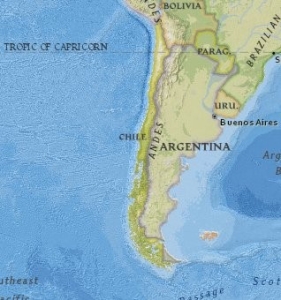Chile – An Emerging Energy Market – Part One
Continuing our series analyzing other countries in the Western Hemisphere, we take a look at the country of Chile. This two-part post examines the country’s resources and energy usage to see how they connect to the global LPG markets.
Location and Natural Resources
Located on the southwestern side of South America, Chile is a country made up of diverse geographical regions and rich mineral deposits. According to the United States Geological Survey (USGS), Chile is the top copper producer in the world and the second largest producer of lithium.
Chile is the only member of the Organization for Economic Cooperation and Development (OECD) in South America. The country is the fifth largest consumer of energy on the continent. However, unlike most other large economies in the region, they are only a minor producer of fossil fuels. Due to this fact, the country is highly dependent on energy imports.
Oil Reserves, Production, and Imports
Low Reserves
Chile had crude oil reserves of 150 million barrels, which is a relatively low amount for Central and South America. The country produced negligible amounts of oil in 2015, while importing more than 304,000 barrels per day (b/d). Imports were split between refined oil products (approximately 150,000 b/d) and crude oil (167,000 b/d).
Low Production and Imports
In February 2023, production reached 1750 b/d, an amount too small to meet the country’s annual demands and needs.
Traditionally, most of Chile’s crude oil imports originated from other South American countries, particularly Brazil, Ecuador, Colombia, Peru, and Argentina. As of 2015, Chile was importing the vast majority (98%) of its crude oil supply from Brazil and Ecuador. Chile imports most refined petroleum products from the United States.
Natural Gas Production and Imports
Declining Natural Gas Production
The Chilean energy industry is dominated by onshore natural gas production from the Magallanes Basin in the Magallanes Region. The amount of natural gas produced is declining though. In 2020, the amount of natural gas produced was 140 million cubic feet per day (MMcfd), while the estimated production amount for 2025 is 92MMcfd.
This field produced 81.34MMcfd in 2020, 53% of Chile’s total production. However, it is estimated to decline 31% to 56.15MMcfd by 2025.
Declining Imports from Neighbor, Argentina
Chile also imports very small amounts of natural gas from Argentina by various pipelines constructed in the late 1990s. Imports from Argentina grew dramatically in the decade that followed. However, natural gas production declined in Argentina over the past decade due to upstream sector underinvestment and higher Argentine demand. This led Chile to expedite its development of LNG import capabilities.
Government Support for Increasing Domestic Energy Production
To increase its domestic oil supply, Chile has carried out exploratory drilling in the Magallanes Basin, a shale formation. There are an estimated 2.4 billion barrels of shale oil in this formation.
In 2014, the government created an energy agenda that would provide for a cleaner, cheaper and more sustainable power generation supply to meet long term growth needs. One of the primary objectives of the initiative was to eliminate the red-tape hampering non-conventional renewable energy deployment and increase power generation by these resources to 45% of the country’s installed capacity by 2025.
LPG in Chile
Chile’s Emerging Energy Market
Though Chile is a large energy consumer, the country’s heavy dependence on imports creates unique challenges. Because it is so dependent on imports, Chile is sensitive to global market dynamics.
LPG demand is increasing steadily in both residential and commercial sectors in Chile. Additionally, the demand for Autogas as a clean, economical fuel is growing. The government’s support for cleaner, cheaper, and sustainable energy to meet long-term growth is encouraging deployment and growth of renewable energy options.
These factors could have a large impact on the global propane markets in the coming years. This is why Twin Feathers is watching this market with interest. Check back for Part Two of our post on Chile where we explore in depth the country’s growing demand for LPG, their dependence on imports and what that could mean for the global markets.
Chile – An Emerging Energy Market
By Gabriel Amundarain











